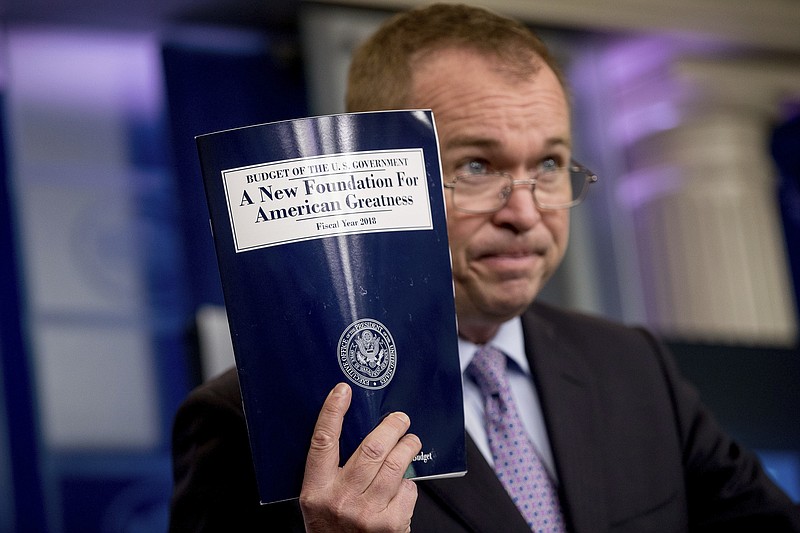The Trump administration has finally unveiled its full 2018 $4 trillion budget, and it looks penny wise and pound foolish.
In true Trump hyperbole, the budget plan is based on the premise that much of what America now spends is wasteful - both domestically and overseas.
So President Trump's plan looks to redistribute American dollars by taking from the poor and middle class and giving to the richest of the rich - all the while imagining that by increasing income to the rich, we will spur economic growth. Sound familiar? Helping the wealthy "job creators" will result in more jobs created for the poor - who, by the way, will no longer have available any "safety-net" supports like access to health care, food stamps or housing subsidies.
Under Trump's plan, Americans would see cuts over 10 years of more than $3 trillion in programs like Medicaid, food stamps and Children's Health Insurance program.
Let's bring this home in just one category.
Medicaid, established in 1965, covers more than 1.5 million of Tennessee's 6.6 million residents under a program we know as TennCare. TennCare covers about 25 percent of the state's residents, primarily low-income pregnant women, children and individuals who are elderly or have a disability. TennCare pays for 50 percent of the state's births, and covers 50 percent of the state's children. In Georgia, Medicaid - under various names like PeachCare - covers about 1.8 million people.
By 2014, about 80 million individuals were enrolled in Medicaid nationwide, and according to the Kaiser Family Foundation, Medicaid accounted for "$1 out of every $6 spent on health care" in the United States.
Yet Trump's budget would cut Medicaid, which was expanded in many states by the Affordable Care Act, by nearly half - slashing $800 billion in the next 10 years. Critics of Medicaid say its spending is unsustainable. Supporters say the program provides better benefits at a lower cost than private insurance.
The fallacy of Trump's budget - think just for a moment of cutting these Medicaid costs alone - is that it doesn't stop people who are poor from getting sick. And when hospitals treat them for "free," someone still has to pay to keep the hospital doors open. If that someone isn't the nation's top taxpayers, who will it be?
We think you get the picture.
The Trump administration believes this budget will balance over 10 years, and by 2027, there will be imagined incredible economic growth based on these too-generous tax cuts coupled with cruel spending cuts. His budgeters also think the people who now get food stamps and other anti-poverty benefits will get back into the workplace and help the economy to grow after we cut them off.
But economists on both liberal and conservative sides question whether Trump's imagined economic growth rate of 3 percent or above is possible.
Jared Bernstein, who was chief economist to former Vice President Joe Biden, told The Washington Post: "These folks seem to look at the economy and conclude that the wealthy don't have enough and the poor have too much, and they're going to fix that."
White House budget director Mick Mulvaney doubts such skepticism.
"That assumes a pessimism about America - about the economy, about its people, about its culture - that we're simply refusing to accept," Mulvaney told national reporters in a briefing early this week.
But Mulvaney's tax-cut thinking has been tried before in Ronald Reagan's "trickle-down" policies, and it failed miserably.
The gap between America's rich and poor is now among the largest in developed countries of the world. Economic experts also say the richest 0.1 percent of U.S. households alone now own about as much as the poorest 90 percent of the country combined - a discrepancy America has not seen since the Great Depression.
And where President Barack Obama sought to narrow that gap, Trump would widen it with this plan.
Earlier this month, congressional negotiators, to avert government shutdown, agreed on a budget deal that didn't include all of these cuts. But the agreement funds the government only through September, meaning Congress must come back to the table.
Aside from poverty program cuts, Congress must give thumbs up or thumbs down to Trump's proposed 13.5 percent cut to the U.S. Department of Education, a 13.2 percent cut to Housing and Urban Development and a 19.8 percent cut to the Department of Labor.
What about the infrastructure improvements Trump promised, along with the jobs that investment would create? It's hard to say, given his proposed 12.7 percent cut to the Department of Transportation, a 16.3 percent cut to the Corps of Engineers, a 10.9 percent drop in Interior Department spending and a 31.4 percent drop for the Environmental Protection Agency.
Will better international relations and trade help us? Sure, but how does a 29.1 percent slashing of the State Department budget and international aid get us there?
What we will spend 6.8 percent more on is the Department of Homeland Security, along with 10.1 percent more in the Department of Defense and 5.8 percent more in the Department of Veterans Affairs.
Apparently young Americans from now on should plan to be border patrol agents or soldiers.
